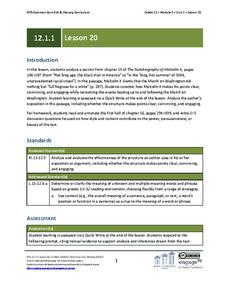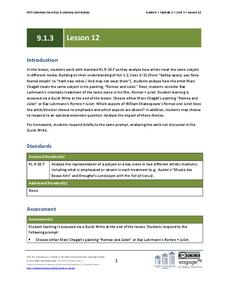Scholastic
Study Jams! Convert Units of Time
How many seconds are in a minute? Or rather, how many seconds are in eight minutes? This problem is worked out through a series of animated steps and explained by a friendly young lady's voice. Your time travelers will appreciate this...
Scholastic
Study Jams! Estimate Whole Numbers
Watch animated slides as RJ explains how to round numbers to the nearest ten and thousand. Viewers then get a chance to try it themselves.
Scholastic
Study Jams! Bar Graphs
Mia teaches Sam how to create a bar graph, including forming a title, creating and labeling the axes, choosing a scale, and entering data. After viewing, data analysts can test themselves with seven follow-up questions and review...
Scholastic
Study Jams! Elapsed Time
Identify the larger number, place the smaller number on the bottom, and then subtract in order to determine elapsed time. Animated slides of each step are also narrated by a friendly voice to teach elementary math minds how to solve such...
Center for Civic Education
The Equal Rights Amendment in the 1970s and Today
Discover the fascinating history of the Equal Rights Amendment and discuss the major implications and considerations associated with it today. Here you will find background information on the topic, a graphic organizer summarizing...
K12 Reader
Tension in the Pit and the Pendulum
Readers will get a peculiar thrilling sensation from this reading comprehension exercise that asks them to identify how Poe uses repetition and sensory language to build tension in his short story, "The Pit and the Pendulum."
Federal Reserve Bank
Invest in Yourself
What are the different ways that people can invest in their human capital for a better future? Pupils participate in an engaging hands-on activity and analyze data regarding unemployment, the ability to obtain an education, and median...
Federal Reserve Bank
So How Much Are You Really Paying for that Loan?
Loans are rarely provided without a cost. Pupils evaluate the high cost of using a payday loan or payday advance through discussion and worksheets, and finally work in groups to develop short public service announcements...
Read Works
Sam’s Helicopter Ride
First graders read a short story and answer questions based on what they read. The question set includes multiple choice and short answer questions.
Read Works
A Busy Bird
Kindergartners read a short passage and answer questions based on what they read. The question set involves circling pictures, writing words, and drawing pictures.
Common Core Sheets
Reading an Analog Clock (5 Minute Increments)
Second and third graders practice reading analog clocks to the nearest five minutes.
Common Core Sheets
Matching Clocks (Half Hour Increments)
First graders read an analog clock and then match it to the corresponding digital clock. Each clock tells time to the nearest 30 minutes.
Common Core Sheets
Finding Elapsed Time with a Numberline
Third graders find the elapsed time on a number line, given the start and end times.
Common Core Sheets
Finding Start Time with a Numberline
Third graders determine the start time on a number line, given the elapsed time and end time.
Common Core Sheets
Finding Ending Time with a Numberline
Third graders determine the end time on a number line, given the start time and elapsed time.
Common Core Sheets
Matching Clocks (5 Minute Increments)
Second graders match the time on an analog clock to the time on a digital clock. Each sheet has 16 problems for solving.
Common Core Sheets
Finding Elapsed Time
Third graders read word problems to determine the elapsed time, given the start and end time.
Read Works
Cats in the Catacombs
Fourth graders read a short story and then answer questions based on what they read. Learners are asked to support their answers with evidence from the text.
Common Core Sheets
Creating Clocks (Half Hour Increments)
First graders create clocks by adding hour and minute hands pointing to the given time. All times are to be written in 30-minute intervals.
Curated OER
Identifying Fraction Location Positive and Negative
Sixth graders practice their fraction and number line skills by identifying where a given fraction is located on the line. Provide mathematicians with a colored pencil for easy identification of the fraction.
EngageNY
Grade 12 ELA Module 1: Unit 1, Lesson 20
The March on Washington takes center stage in the discussion of chapter 15 of The Autobiography of Malcolm X; however, class members are presented with an entirely different view of the march from the ones they have previously studied....
EngageNY
Peer Critique: Historical Accuracy of Ideas and Vocabulary
Promote collaboration in the classroom with a historical fiction instructional activity. Fourth graders partner up and read the other's narrative to give feedback on vocabulary choice and the accuracy of historical information. After...
EngageNY
Grade 9 ELA Module 1: Unit 3, Lesson 12
Marc Chagall's painting Romeo and Juliet and Baz Lurhmann's film of the same scene in Romeo + Juliet allow class members to analyze how artists consider the same subject in different media.
Odell Education
Making Evidence-Based Claims: Grade 8
American women have been working toward equal rights since the ink dried on the Declaration of Independence. Focused on the words and actions of Sojourner Truth, Shirley Chisholm, and Venus Williams, a language arts lesson takes eighth...
Other popular searches
- Common Core Language Arts
- Common Core Math
- Common Core Reading
- Common Core Standards
- Common Core Social Studies
- Common Core Writing
- Common Core Math Lessons
- Science Common Core
- Common Core English
- Common Core Ela
- Common Core Lessons






















